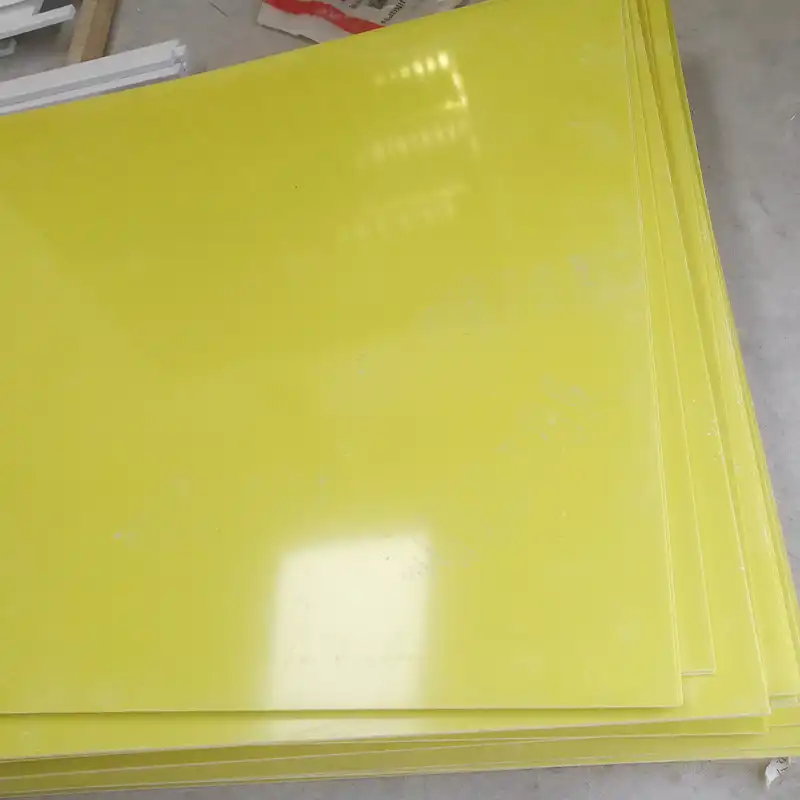Composition and Manufacturing Process of 3240 Epoxy Sheet
Raw Materials and Their Proportions
The 3240 epoxy sheet is a sophisticated composite material crafted from a precise blend of components. At its core, it consists of high-quality epoxy resin, which serves as the matrix, and glass fiber fabric, which acts as the reinforcement. The epoxy resin typically comprises about 30-40% of the total composition, while the glass fiber fabric makes up the remaining 60-70%. This carefully calibrated ratio ensures optimal performance across various parameters.
The epoxy resin used in 3240 epoxy boards is a thermoset polymer known for its exceptional adhesive properties and chemical resistance. It's often a bisphenol A-based epoxy, modified with additives to enhance specific characteristics such as flame retardancy or UV stability. The glass fiber fabric, on the other hand, is usually E-glass, chosen for its excellent electrical insulation properties and high strength-to-weight ratio.
Manufacturing Techniques and Quality Control
The production of 3240 epoxy sheets involves a meticulous manufacturing process that ensures consistent quality and performance. The process begins with the impregnation of the glass fiber fabric with the liquid epoxy resin. This step is crucial as it determines the eventual uniformity and strength of the final product.
Once impregnated, the material undergoes a controlled curing process. This involves the application of heat and pressure in specialized autoclaves or presses. The curing temperature typically ranges between 150°C to 180°C, and the process can take several hours to complete. During this phase, the epoxy resin undergoes a chemical reaction, transforming from a liquid to a solid state while bonding firmly with the glass fibers.
Quality control measures are implemented at every stage of production. These include:
- Resin content analysis to ensure the correct ratio of resin to fiber
- Void content assessment to minimize air pockets that could compromise strength
- Dimensional checks to guarantee consistent thickness and flatness
- Destructive and non-destructive testing to verify mechanical and electrical properties
Post-Processing and Customization Options
After the initial manufacturing process, 3240 epoxy sheets can undergo various post-processing treatments to enhance their properties or tailor them for specific applications. These treatments may include:
- Surface finishing: Sanding or polishing to achieve desired smoothness - Machining: Cutting, drilling, or milling to create custom shapes and sizes - Coating: Application of specialized coatings for improved UV resistance or hydrophobicity - Heat treatment: Additional thermal processing to fine-tune mechanical properties
Customization options also extend to the incorporation of additives during the manufacturing process. These can include flame retardants, colorants, or nanoparticles to impart specific properties such as enhanced thermal conductivity or electromagnetic shielding.
Physical and Mechanical Properties of 3240 Epoxy Board
Density and Dimensional Stability
The 3240 epoxy board exhibits exceptional density and dimensional stability, attributes that contribute significantly to its widespread use in precision engineering applications. The density of 3240 epoxy sheets typically ranges from 1.7 to 1.9 g/cm³, striking an optimal balance between strength and weight. This relatively low density, compared to many metals, makes the material an attractive option for applications where weight reduction is crucial, such as in aerospace or automotive industries.
Dimensional stability is a hallmark feature of 3240 epoxy boards. The material demonstrates minimal dimensional changes under varying environmental conditions, including temperature fluctuations and humidity exposure. The coefficient of thermal expansion (CTE) for 3240 epoxy sheets is remarkably low, usually in the range of 10-20 × 10^-6 /°C in the x-y plane. This property ensures that components made from 3240 epoxy maintain their shape and size, even in challenging operational environments, making them ideal for applications requiring high precision and reliability.
Tensile Strength and Modulus
The mechanical robustness of 3240 epoxy sheets is exemplified by their impressive tensile properties. The tensile strength of these materials typically ranges from 300 to 400 MPa, rivaling or exceeding many metals while maintaining a fraction of their weight. This high strength-to-weight ratio is a key factor in the material's popularity in structural applications.
The tensile modulus, or Young's modulus, of 3240 epoxy boards is equally noteworthy, generally falling between 15 to 20 GPa. This high stiffness ensures that components made from 3240 epoxy resist deformation under load, maintaining their structural integrity even in demanding applications. The combination of high strength and high modulus makes 3240 epoxy sheets an excellent choice for load-bearing structures in various industries.
Impact Resistance and Toughness
While 3240 epoxy sheets are known for their strength and stiffness, they also possess remarkable impact resistance and toughness. The material's ability to absorb and dissipate energy from sudden impacts without catastrophic failure is a critical characteristic in many applications. The Izod impact strength of 3240 epoxy boards typically ranges from 100 to 150 kJ/m², demonstrating their resilience against shock loads.
The toughness of 3240 epoxy sheets is further enhanced by the synergistic interaction between the epoxy matrix and the glass fiber reinforcement. The epoxy resin provides ductility and crack resistance, while the glass fibers act as barriers to crack propagation. This combination results in a material that can withstand not only static loads but also dynamic and cyclic stresses, making it suitable for applications involving vibration or repeated impact.
Electrical and Thermal Characteristics of 3240 Epoxy Sheet
Dielectric Strength and Volume Resistivity
The 3240 epoxy sheet excels in electrical insulation, boasting impressive dielectric strength and volume resistivity. The dielectric strength, which measures the maximum electric field the material can withstand without breakdown, typically ranges from 20 to 25 kV/mm for 3240 epoxy boards. This high value ensures reliable insulation even under intense electrical stress, making the material ideal for high-voltage applications.
Volume resistivity, another critical electrical property, is exceptionally high for 3240 epoxy sheets, often exceeding 10^14 ohm-cm. This characteristic indicates the material's strong resistance to electrical current flow through its bulk, further cementing its status as an excellent electrical insulator. The combination of high dielectric strength and volume resistivity makes 3240 epoxy boards indispensable in electrical and electronic industries, particularly in the manufacture of switchgear, transformers, and circuit boards.
Thermal Conductivity and Heat Resistance
While primarily known for its electrical insulation properties, the 3240 epoxy sheet also demonstrates noteworthy thermal characteristics. The thermal conductivity of 3240 epoxy boards typically falls in the range of 0.3 to 0.5 W/mK. This relatively low thermal conductivity contributes to the material's effectiveness as a thermal insulator, making it suitable for applications where heat management is crucial.
Heat resistance is another standout feature of 3240 epoxy sheets. The material maintains its mechanical and electrical properties at elevated temperatures, with a glass transition temperature (Tg) often exceeding 150°C. This high-temperature stability allows 3240 epoxy boards to perform reliably in environments where other materials might fail, such as in automotive under-hood applications or industrial machinery operating at elevated temperatures.
Flame Retardancy and Smoke Emission
Safety considerations in material selection often prioritize flame retardancy and smoke emission characteristics. The 3240 epoxy sheet rises to meet these challenges with aplomb. Many formulations of 3240 epoxy boards are engineered to achieve UL 94 V-0 rating, the highest standard for flammability resistance in plastic materials. This rating indicates that the material self-extinguishes within 10 seconds after ignition and does not produce flaming drips.
Equally important is the low smoke emission property of 3240 epoxy sheets. When exposed to fire, these materials produce minimal smoke, reducing visibility issues and toxic inhalation risks during emergencies. This combination of flame retardancy and low smoke emission makes 3240 epoxy boards particularly valuable in applications where fire safety is paramount, such as in aerospace interiors, public transportation, and building materials.
Conclusion
The 3240 epoxy sheet stands as a testament to advanced material engineering, offering a unique blend of mechanical strength, electrical insulation, and thermal stability. Its versatility and exceptional performance parameters make it an invaluable asset across diverse industries, from electrical and electronics to aerospace and automotive. As technology continues to evolve, the demand for high-performance materials like the 3240 epoxy board is likely to grow, driving further innovations in its composition and manufacturing processes. The material's ability to meet stringent requirements while offering customization options positions it as a cornerstone in modern engineering solutions, promising continued relevance in the face of emerging technological challenges.
Contact Us
For more information about our 3240 epoxy sheets and how they can benefit your specific application, please don't hesitate to contact us at info@jhd-material.com. Our team of experts is ready to assist you in finding the perfect solution for your needs.






